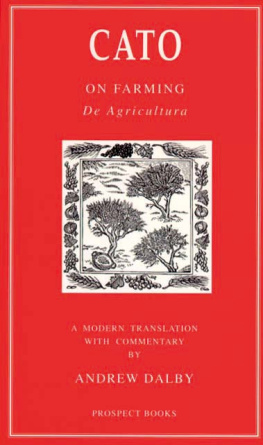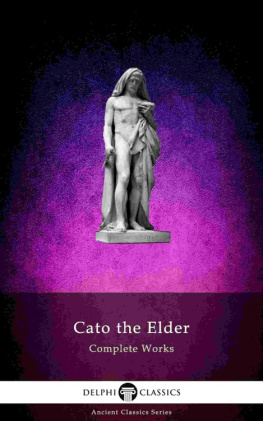[Transcriber's note: The extensive and lengthy footnotes have been renumbered and placed at the end of the book.]
PREFACE
The present editor made the acquaintance of Cato and Varro standing at a book stall on the Quai Voltaire in Paris, and they carried him away in imagination, during a pleasant half hour, not to the vineyards and olive yards of Roman Italy, but to the blue hills of a far distant Virginia where the corn was beginning to tassel and the fat cattle were loafing in the pastures. Subsequently, when it appeared that there was then no readily available English version of the Roman agronomists, this translation was made, in the spirit of old Piero Vettori, the kindly Florentine scholar, whose portrait was painted by Titian and whose monument may still be seen in the Church of Santo Spirito: in the preface of his edition of Varro he says that he undertook the work, not for the purpose of displaying his learning, but to aid others in the study of an excellent author. Victorius was justified by his scholarship and the present editor has no such claim to attention: he, therefore, makes the confession frankly (to anticipate perhaps such criticism as Bentley's "a very pretty poem, Mr. Pope, but don't call it Homer") and offers the little book to those who love the country, and to read about the country amidst the crowded life of towns, with the hope that they may find in it some measure of the pleasure it has afforded the editor.
The texts and commentaries used have been those of Schneider and Keil, the latter more accurate but the former more sympathetic.
F.H. BELVOIR,
Fauquier County,
Virginia.
December, 1912.
FOREWORD TO SECOND EDITION
The call for a reprint of this book has afforded the opportunity to correct some errors and to make several additions to the notes.
In withholding his name from the title page the editor sought not so much to conceal his identity as to avoid the appearance of a parade in what was to him the unwonted field of polite literature. As, however, he is neither ashamed of the book nor essays the rle of
A violet by a mossy stone
Half hidden from the eye,
he now and here signs his name.
FAIRFAX HARRISON.
BELVOIR HOUSE,
Christmas, 1917.
CONTENTS
NOTE UPON THE ROMAN AGRONOMISTS NOTE ON THE OBLIGATION OF VIRGIL TO VARRO
* * * * *
CATO'S DE AGRICULTURA
SYNOPSIS
Introduction: Of the Dignity of the Farmer
Of Buying a Farm
Of the Duties of the Owner
Of Laying out the Farm
Of Stocking the Farm
Of the Duties of the Overseer
Of the Duties of the Housekeeper
Of the Hands
Of Draining
Of Preparing the Seed Bed
Of Manure
Of Soil Improvement
Of Forage Crops
Of Planting
Of Pastures
Of Feeding Live Stock
Of the Care of Live Stock
Of Cakes and Salad
Of Curing Hams
VARRO'S RERUM RUSTICARUM LIBRI TRES
SYNOPSIS
BOOK I
THE HUSBANDRY OF AGRICULTURE
CHAPTER
I. Introduction: the literary tradition of country life
Of the definition of Agriculture:
II. a. What it is not
III. b. What it is
IV. The purposes of Agriculture are profit and pleasure
V. The four-fold division of the study of Agriculture
I Concerning the farm itself:
VI. How conformation of the land affects Agriculture
VII. How character of soil affects Agriculture
VIII. (A digression on the maintenance of vineyards)
IX. Of the different kinds of soils
X. Of the units of area used in measuring land
Of the considerations on building a steading:
XI. a. Size
b. Water supply
XII. c. Location, with regard to health
XIII. d. Arrangement
Of the protection of farm boundaries:
XIV. a. Fences
XV. b. Monuments
XVI. Of the considerations of neighbourhood
2 Concerning the equipment of a farm: XVII. } & }Of agricultural labourers XVIII.} XIX. } & }Of draught animals XX. } XXI. Of watch dogs XXII. Of farming implements
3 Concerning the operation of a farm: XXIII. Of planting field crops XXIV. Of planting olives XXV. } & } Of planting vines XXVI.}
4 Concerning the agricultural seasons: XXVII. } & }Of the solar measure of the year, illustrated by XXVIII.}
A CALENDAR OF AGRICULTURAL OPERATIONS throughout the year, in eight seasons, viz:
XXIX. 1 February 7-March 24
XXX. 2 March 24-May 7
XXXI. 3 May 7-June 24
XXXII. 4 June 24-July 21
XXXIII. 5 July 21-September 26
XXXIV. 6 September 26-October 28
XXXV. 7 October 28-December 24
XXXVI. 8 December 24-February 7
XXXVII. Of the influence of the moon on Agriculture to which is added
ANOTHER CALENDAR OF SIX AGRICULTURAL SEASONS with a commentary on their several occupations, viz:
CHAPTER 1 Preparing time: Of tillage, XXXVIII. Of manuring,
XXXIX. 2 Planting time:
Of the four methods of propagating plants, viz:
XL. a. Seeding and here of seed selection b. Transplanting c. Cuttage d. Graftage, and e. A "new" method, inarching XLI. Of when to use these different methods XLII. Of seeding alfalfa XLIII. Of seeding clover and cabbage XLIV. Of seeding grain
3 Cultivating time:
XLV. Of the conditions of plant growth
XLVI. Of the mechanical action of plants
XLVII. Of the protection of nurseries and meadows
XLVIII. Of the structure of a wheat plant
XLIX. 4 Harvest time:
Of the hay harvest
L. Of the wheat harvest
LI. The threshing floor
LII. Threshing and winnowing
LIII. Gleaning
LIV. Of the vintage
LV. Of the olive harvest
5 Housing time:
LVI. Of storing hay
LVII. Of storing grain
LVIII. Of storing legumes
LIX. Of storing pome fruits
LX. Of storing olives
LXI. Of storing amurca
LXII. 6 Consuming time:
LXIII. Of cleaning grain
LXIV. Of condensing amurca
LXV. Of racking wine
LXVL. Of preserved olives
LXVIL. Of nuts, dates and figs
LXVIII. Of stored fruits
LXIX. Of marketing grain
Epilogue: the dangers of the streets of Rome
BOOK II
THE HUSBANDRY OF LIVE STOCK
Introduction:the decay of country life
I. Of the origin, the importance and the economy of live stock husbandry
II. Of sheep
III. Of goats
IV. Of swine
V. Of neat cattle
VI. Of asses
VII. Of horses
VIII. Of mules
IX. Of herd dogs
N. Of shepherds
XI. Of milk and cheese and wool
BOOK III
THE HUSBANDRY OF THE STEADING
I. Introduction: the antiquity of country life
II. Of the definition of a Roman villa
III. Of the Roman development of the industries of the steading
IV. Of aviaries
V. a. for profit
b. for pleasure (including here the description of Varro's own aviary)
VI. Of pea-cocks
VII. Of pigeons
VIII. Of turtle doves
IX. Of poultry
X. Of geese
XI. Of ducks
XII. Of rabbits
XIII. Of game preserves
XIV. Of snails
XV. Of dormice
XVI. Of bees
XVII. Of fish ponds










